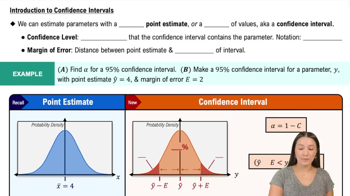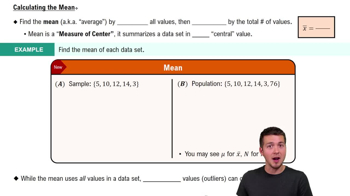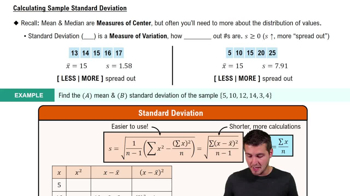Mean Assume that we want to use the sample data given in Exercise 1 with the bootstrap method to estimate the population mean. The mean of the values in Exercise 1 is 54.3 seconds, and the mean of all of the tobacco times in Data Set 20 “Alcohol and Tobacco in Movies” from Appendix B is 57.4 seconds. If we use 1000 bootstrap samples and find the corresponding 1000 means, do we expect that those 1000 means will target 54.3 seconds or 57.4 seconds? What does that result suggest about the bootstrap method in this case?
Table of contents
- 1. Intro to Stats and Collecting Data1h 14m
- 2. Describing Data with Tables and Graphs1h 55m
- 3. Describing Data Numerically2h 5m
- 4. Probability2h 16m
- 5. Binomial Distribution & Discrete Random Variables3h 6m
- 6. Normal Distribution and Continuous Random Variables2h 11m
- 7. Sampling Distributions & Confidence Intervals: Mean3h 23m
- Sampling Distribution of the Sample Mean and Central Limit Theorem19m
- Distribution of Sample Mean - Excel23m
- Introduction to Confidence Intervals15m
- Confidence Intervals for Population Mean1h 18m
- Determining the Minimum Sample Size Required12m
- Finding Probabilities and T Critical Values - Excel28m
- Confidence Intervals for Population Means - Excel25m
- 8. Sampling Distributions & Confidence Intervals: Proportion1h 12m
- 9. Hypothesis Testing for One Sample3h 29m
- 10. Hypothesis Testing for Two Samples4h 50m
- Two Proportions1h 13m
- Two Proportions Hypothesis Test - Excel28m
- Two Means - Unknown, Unequal Variance1h 3m
- Two Means - Unknown Variances Hypothesis Test - Excel12m
- Two Means - Unknown, Equal Variance15m
- Two Means - Unknown, Equal Variances Hypothesis Test - Excel9m
- Two Means - Known Variance12m
- Two Means - Sigma Known Hypothesis Test - Excel21m
- Two Means - Matched Pairs (Dependent Samples)42m
- Matched Pairs Hypothesis Test - Excel12m
- 11. Correlation1h 6m
- 12. Regression1h 50m
- 13. Chi-Square Tests & Goodness of Fit1h 57m
- 14. ANOVA1h 57m
7. Sampling Distributions & Confidence Intervals: Mean
Confidence Intervals for Population Mean
Problem 7.2.13
Textbook Question
Archeology Archeologists have studied sizes of Egyptian skulls in an attempt to determine whether breeding occurred between different cultures. Listed below are the widths (mm) of skulls from 150 A.D. (based on data from Ancient Races of the Thebaid by Thomson and Randall-Maciver). Construct a 99% confidence interval estimate of the mean skull width.

 Verified step by step guidance
Verified step by step guidance1
Step 1: Calculate the sample mean (\( \bar{x} \)) of the given skull widths. Add all the skull widths together and divide by the total number of data points. The formula is \( \bar{x} = \frac{\sum x_i}{n} \), where \( x_i \) are the individual data points and \( n \) is the sample size.
Step 2: Calculate the sample standard deviation (\( s \)) using the formula \( s = \sqrt{\frac{\sum (x_i - \bar{x})^2}{n-1}} \). Subtract the mean from each data point, square the result, sum these squared differences, divide by \( n-1 \), and then take the square root.
Step 3: Determine the critical value (\( t^* \)) for a 99% confidence level using a t-distribution table. The degrees of freedom (df) are \( n-1 \). For this problem, \( n = 8 \), so \( df = 7 \). Look up the critical value corresponding to a 99% confidence level and \( df = 7 \).
Step 4: Calculate the margin of error (ME) using the formula \( ME = t^* \cdot \frac{s}{\sqrt{n}} \). Multiply the critical value by the standard error, which is the sample standard deviation divided by the square root of the sample size.
Step 5: Construct the confidence interval using the formula \( \text{Confidence Interval} = \bar{x} \pm ME \). Add and subtract the margin of error from the sample mean to find the lower and upper bounds of the confidence interval.
 Verified video answer for a similar problem:
Verified video answer for a similar problem:This video solution was recommended by our tutors as helpful for the problem above
Video duration:
6mPlay a video:
Was this helpful?
Key Concepts
Here are the essential concepts you must grasp in order to answer the question correctly.
Confidence Interval
A confidence interval is a range of values, derived from sample statistics, that is likely to contain the population parameter with a specified level of confidence. For example, a 99% confidence interval suggests that if we were to take many samples and construct intervals in the same way, approximately 99% of those intervals would contain the true population mean.
Recommended video:

Introduction to Confidence Intervals
Mean
The mean, or average, is a measure of central tendency calculated by summing all the values in a dataset and dividing by the number of values. It provides a single value that represents the center of the data distribution, making it easier to understand the overall trend of the data, such as the average skull width in this case.
Recommended video:
Guided course

Calculating the Mean
Standard Deviation
Standard deviation is a statistic that measures the dispersion or spread of a set of values around the mean. A low standard deviation indicates that the values tend to be close to the mean, while a high standard deviation indicates a wider spread. It is crucial for calculating the confidence interval, as it helps determine how much variability exists in the skull width measurements.
Recommended video:
Guided course

Calculating Standard Deviation

 4:48m
4:48mWatch next
Master Population Standard Deviation Known with a bite sized video explanation from Patrick
Start learningRelated Videos
Related Practice
Textbook Question
